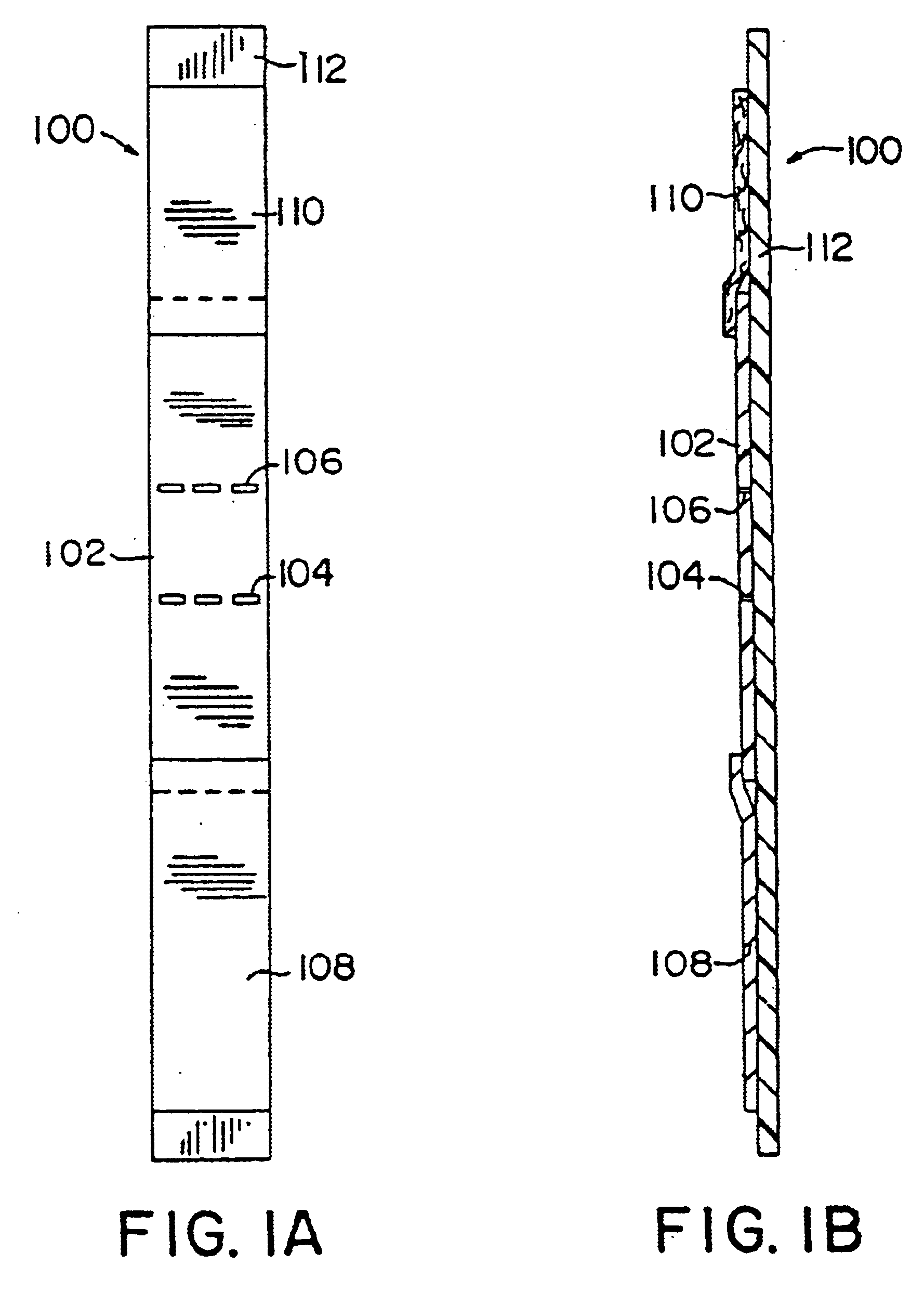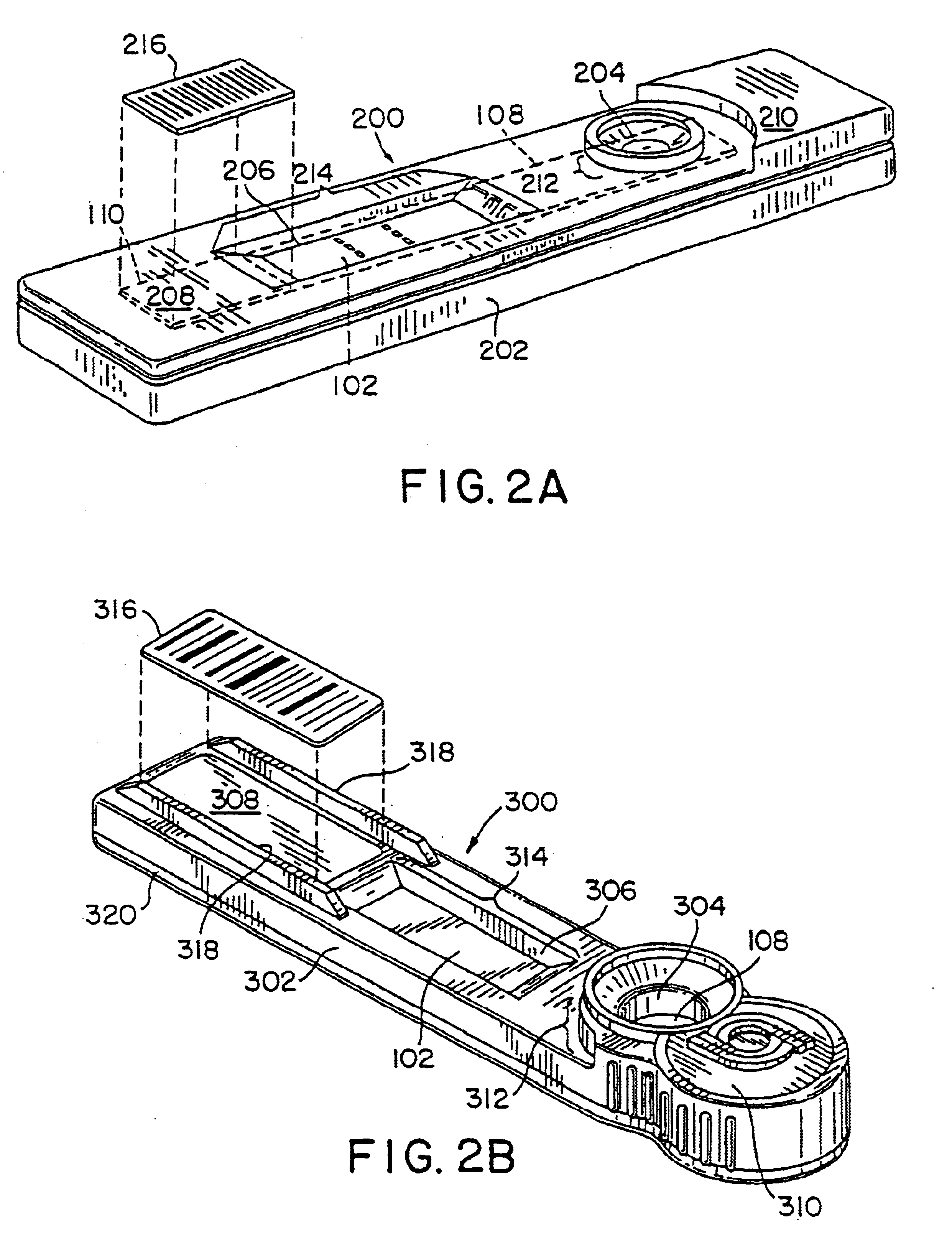Point of care diagnostic systems
a diagnostic system and point of care technology, applied in the direction of material analysis, medical report generation, optical light guide, etc., can solve the problems of large subjectivity involved, and achieve the effect of minimizing the error between images
- Summary
- Abstract
- Description
- Claims
- Application Information
AI Technical Summary
Benefits of technology
Problems solved by technology
Method used
Image
Examples
example 1
Immunoassay Test Strip
A. The Test Strip
The test strip 100 includes a membrane system including three components: a porous or bibulous member 102; a conjugate pad 108; and an absorbent pad 110. The membrane system may be mounted on a substrate or backing 112, with the conjugate pad 108 and the absorbent pad 110 slightly overlapping the porous or bibulous member 102, which is interposed thereinbetween. As can be seen in FIGS. 1A and 1B, the conjugate pad 108 overlaps the porous or bibulous member 102 so that a fluid sample placed onto the conjugate pad 108 is communicated from the conjugate pad 108 to the porous or bibulous member 102. Similarly, the absorbent pad 110 overlaps with the porous or bibulous member 102 so that fluid samples introduced into the porous or bibulous member 102 from the conjugate pad 108 can then be transmitted to the absorbent pad 110. Thus, the conjugate pad 108, the absorbent pad 110 and the porous or bibulous member 102 are all in fluid communication with ...
example 2
Immunoassay Procedure
In conducting the assay, the sample is extracted from a swab into antiprotease transfer buffer (0.05 M Tris buffer, pH 7.4, 1% BSA, 5 mM EDTA, 1 mM phenylmethylsulfonyl fluoride (PMSF), and 500 Kallikrein Units / ml of Aprotinin), heated for 15 min. at 37° C. and filtered through a large pore (25μ) plunger filter. A volume of 200 μl of test sample is then delivered to the conjugate pad at the application zone using a standard plastic pipet. Any fFN in the sample will bind to the labeled monoclonal antibody and the resulting complex migrates into the nitrocellulose strip. When the complex encounters the detection zone, the immobilized anti-FN antibody binds the complex, thereby forming a colored stripe due to the aggregation of the dye-containing latex beads. Any unbound latex-conjugated anti-fFN antibody continues to migrate into the control zone, where it is captured by the immobilized goat anti-mouse antibody and thereby forms a colored str...
example 3
Operation of the Reflectance Reader
The test strip is read using the reflectance reader exemplified herein. This reader (described above) is adapted to read an immunochromatographic test strip supported within the housing. The reflectance reader includes a cassette slot for receiving the test-strip housing, and a sensing head assembly for reading the test strip supported within the test-strip housing using reflected light. The sensing head assembly includes a first light-emitting diode (LED1), a second LED (LED2), a silicon photodiode detector, and 39 optical fibers randomly arranged in a narrow slit (e.g., 0.020″ wide) located at the bottom of the sensing head assembly. LED, emits light with a wavelength of 430 nm (blue), and LED2 emits light with a wavelength of 595 nm (amber). The optical fibers are arranged in three groups of 13 optical fibers each: the first group transmits light emitted by LED1 to the slit; the second group transmits light emitted by LED2 to the slit; and the t...
PUM
| Property | Measurement | Unit |
|---|---|---|
| time | aaaaa | aaaaa |
| time | aaaaa | aaaaa |
| distance | aaaaa | aaaaa |
Abstract
Description
Claims
Application Information
 Login to View More
Login to View More - R&D
- Intellectual Property
- Life Sciences
- Materials
- Tech Scout
- Unparalleled Data Quality
- Higher Quality Content
- 60% Fewer Hallucinations
Browse by: Latest US Patents, China's latest patents, Technical Efficacy Thesaurus, Application Domain, Technology Topic, Popular Technical Reports.
© 2025 PatSnap. All rights reserved.Legal|Privacy policy|Modern Slavery Act Transparency Statement|Sitemap|About US| Contact US: help@patsnap.com



